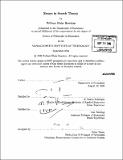| dc.contributor.advisor | K. Daron Acemoglu and Iván Werning. | en_US |
| dc.contributor.author | Hawkins, William Blake | en_US |
| dc.contributor.other | Massachusetts Institute of Technology. Dept. of Economics. | en_US |
| dc.date.accessioned | 2007-05-16T18:32:51Z | |
| dc.date.available | 2007-05-16T18:32:51Z | |
| dc.date.copyright | 2006 | en_US |
| dc.date.issued | 2006 | en_US |
| dc.identifier.uri | http://hdl.handle.net/1721.1/37410 | |
| dc.description | Thesis (Ph. D.)--Massachusetts Institute of Technology, Dept. of Economics, 2006. | en_US |
| dc.description | Includes bibliographical references (p. 157-163). | en_US |
| dc.description.abstract | I investigate search models in which firms wish to employ multiple workers. I first focus on efficiency. One important approach to modeling frictional labor markets is competitive search equilibrium, in which workers direct their search towards wages that firms commit to pay them upon hire. If each firm wishes to hire precisely one worker, the competitive search equilibrium is efficient (Moen, 1997; Shimer, 1996). I show that if firms wish to employ multiple workers, then hiring will not generally be efficient if firms post only a single wage. Efficiency requires that firms commit to hire a fixed number of workers at the posted wage, to pay all applicants, or to make wages contingent on the number of applicants. I show that if firms post only a wage, the amount of inefficiency is highest at intermediate levels of labor market tightness. Efficiency under wage posting is restored in a dynamic model if the duration for which firms commit to posted contracts becomes small. I next calibrate a continuous-time version of the model to US data. Under the benchmark parametrization and in response to plausible business-cycle shocks to productivity, the model does not produce fluctuations in unemployment that match the amplitude of such fluctuations in US data. | en_US |
| dc.description.abstract | (cont.) It appears that the existence of firms that wish to employ multiple workers is not per se a source of much amplification. Finally, Daron Acemoglu and I present a generalization of the Diamond-Mortensen-Pissarides (DMP) search model of unemployment which incorporates both intensive and extensive margins of employment creation. Firms possess a production technology with diminishing returns to labor, and recruit workers by posting vacancies. Entry by new firms corresponds to the extensive margin of employment creation, while job creation by existing firms captures the intensive margin. As in the baseline DMP model and theories of the firm developed by Stole and Zwiebel (1996a,b) and Wolinsky (2000), wages are determined by continuous bargaining between the firm and its employees. We characterize the steady-state equilibrium in this class of models and discuss the implications of various different types of shocks on the equilibrium unemployment rate. | en_US |
| dc.description.statementofresponsibility | by William Blake Hawkins. | en_US |
| dc.format.extent | 163 p. | en_US |
| dc.language.iso | eng | en_US |
| dc.publisher | Massachusetts Institute of Technology | en_US |
| dc.rights | M.I.T. theses are protected by copyright. They may be viewed from this source for any purpose, but reproduction or distribution in any format is prohibited without written permission. See provided URL for inquiries about permission. | en_US |
| dc.rights.uri | http://dspace.mit.edu/handle/1721.1/7582 | |
| dc.subject | Economics. | en_US |
| dc.title | Essays in search theory | en_US |
| dc.type | Thesis | en_US |
| dc.description.degree | Ph.D. | en_US |
| dc.contributor.department | Massachusetts Institute of Technology. Department of Economics | |
| dc.identifier.oclc | 123027730 | en_US |
